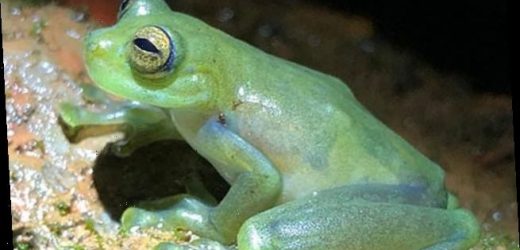Frogs living near waterfalls WAVE to try and attract females when the noise of the gushing torrent drowns out their mating calls
- Glass frog species has been captured on video showing off with a flap of its hand
- It also uses a wave of a foot and a bob of the head to attract any potential mates
- This behaviour has evolved so the species is noticed above noise of a waterfall
Frogs living near noisy waterfalls in South America wave to attract mates, a new study reveals.
In field studies, a US expert studied the glass frog (Sachatamia orejuela), which is found on slippery rocky surfaces near the water.
Video footage reveals a male specimen showing off with a casual flap of the hand, a wave of its foot and a friendly nod of the head in the hope of being noticed.
S. orejuela is one of a few species around the world that have evolved visual communication to be noticed amid the background noise generated by rushing water in its natural habitat.
These cues let potential mates be noticed when their calls are drowned out by the noise, ensuring reproduction and species survival.
Scroll down for video
To increase conspicuousness and counter the background noise generated by rushing water, a few frog species around the world have evolved visual communication. Pictured, a glass frog. The species is named for its semi-transparent skin
https://youtube.com/watch?v=U6prmVIyxXI%3Frel%3D0%26showinfo%3D1
Glass frogs are frogs of the amphibian family Centrolenidae.
They live in the humid mountain forests of Central and South America.
The rainforests are called cloud forests because the area is almost always covered in clouds.
Glass frogs are mostly active at night, which makes them very difficult to spot for predators.
During the breeding season they live along rivers and streams where they lay their eggs on leaves that overhang the water.
The bodies of glass frogs are bright green on their backs, while their abdominal skin is translucent.
This means that the animal’s heart, liver and gastrointestinal tract are visible.
The first glass frog was discovered in 1872.
They are thought to have originated in South America before spreading into Central America.
Glass frogs are generally small, ranging from an inch to three inches in length (2.5cm to 7.5cm).
They may look similar to tree frogs, but their eyes face forward, instead of sideways.
The frogs are mostly arboreal, meaning that they live in trees and can be found along rivers and streams during the breeding season.
This new study marks the first time a member of the glass frog family (Centrolenidae) has been observed using visual communication in this manner.
‘A handful of other frog species around the world use visual signalling, in addition to high-pitched calls, to communicate in really loud environments,’ said conservation ecologist Rebecca Brunner at the University of California, Berkeley.
‘This is a really exhilarating discovery because it’s a perfect example of how an environment’s soundscape can influence the species that live there.
‘What’s interesting is that these species are not closely related to each other, which means that these behaviours likely evolved independently, but in response to similar environments – a concept called convergent evolution.’
Sachatamia orejuela glass frogs are native to the rainforests of Ecuador and Colombia in South America.
They are almost exclusively found on rocks and boulders within the spray zones of waterfalls, where rushing water and slippery surfaces offer some protection against predators such as snakes, mammals and birds.
Their characteristic green-grey colour and semi-transparent skin, which give them their common name, also make them nearly impossible to spot.
‘Glass frogs are difficult to find and collect, due not only to their small size and colour, but also because of the extreme areas they sometimes inhabit,’ Spanish wildlife photographer Nic Reusens previously said.
‘Glass frogs are often found along streams that are nearly impossible to walk along, let alone collect specimens.’
The problem with this for scientists is little information has been gathered about this species’ mating and breeding behaviour and it remains ‘poorly studied’, according to Brunner.
Until now, long-distance visual signalling has not been recorded for any species in the glassfrog family (Centrolenidae).
Brunner, who studies the bioacoustics of different ecological environments, was recording the call of a S. orejuela in an Ecuadorean rainforest stream pre-pandemic when she first observed this visual signalling behaviour.
Although most male frogs call to attract females, vocalisations alone can be ineffective long-range signals in certain environments. Rebecca Brunner discovered that Sachatamia orejuela uses both high-pitched calls and visual signalling – in the form of hand-waving, foot-waving and head-bobbing – to communicate near loud waterfalls
As soon as she saw the frog repeatedly raising its front and back legs, Brunner climbed a slippery rock face and balanced on one foot.
‘I was already over the moon because I had finally found a calling male after months of searching,’ she said.
‘Before our publication, there was no official record of this species’ call, and basic information like that is really important for conservation.
‘But then I saw it start doing these little waves, and I knew that I was observing something even more special.’
While she filmed, the frog continued to wave its hands and feet and bob its head.
She also observed another male S. orejuela a few metres away performing the same actions.
Brunner also documented the species’ impressive vocal call that it uses to advertise its availability.
The frequency of the call is higher than perhaps any other glassfrog species, likely an evolutionary response to the ‘disruptive acoustic space’ that it finds itself in.
Brunner’s colleague captured a photo of her climbing a slippery rock face to film the glass frog in Ecuador
‘We’ve found that Sachatamia orejuela has an extremely high-pitched call, which helps it communicate above the lower-pitched white noise of waterfalls,’ said Brunner, who authored her findings with Juan M. Guayasamin from the Universidad San Francisco de Quito in Ecuador.
Though the current pandemic has put a pause on Brunner’s fieldwork, she hopes to return to Ecuador soon to continue her research.
‘One of the best things about fieldwork is that nature is always full of surprises — you never know what discoveries you may happen upon,’ Brunner said.
‘I hope our findings can serve as a reminder that we share this planet with incredible biodiversity.
‘Conserving ecosystems that support species like Sachatamia orejuela is important not only for our well-being, but also for our sense of wonder.’
The study has been published in the journal Behaviour.
Source: Read Full Article




